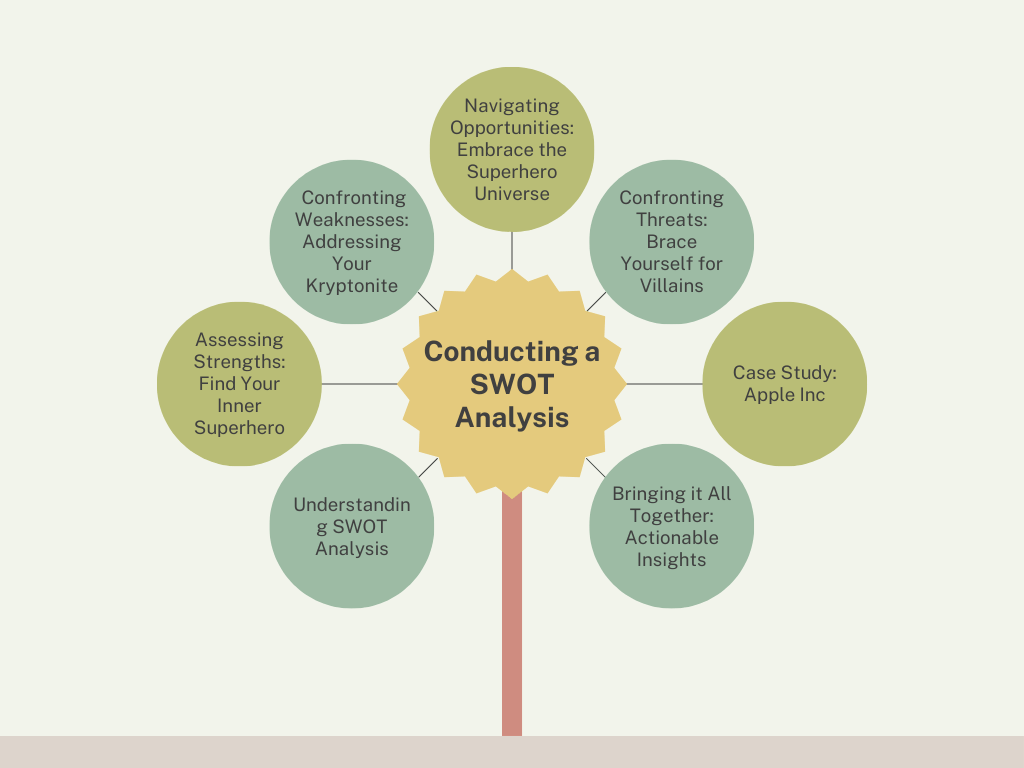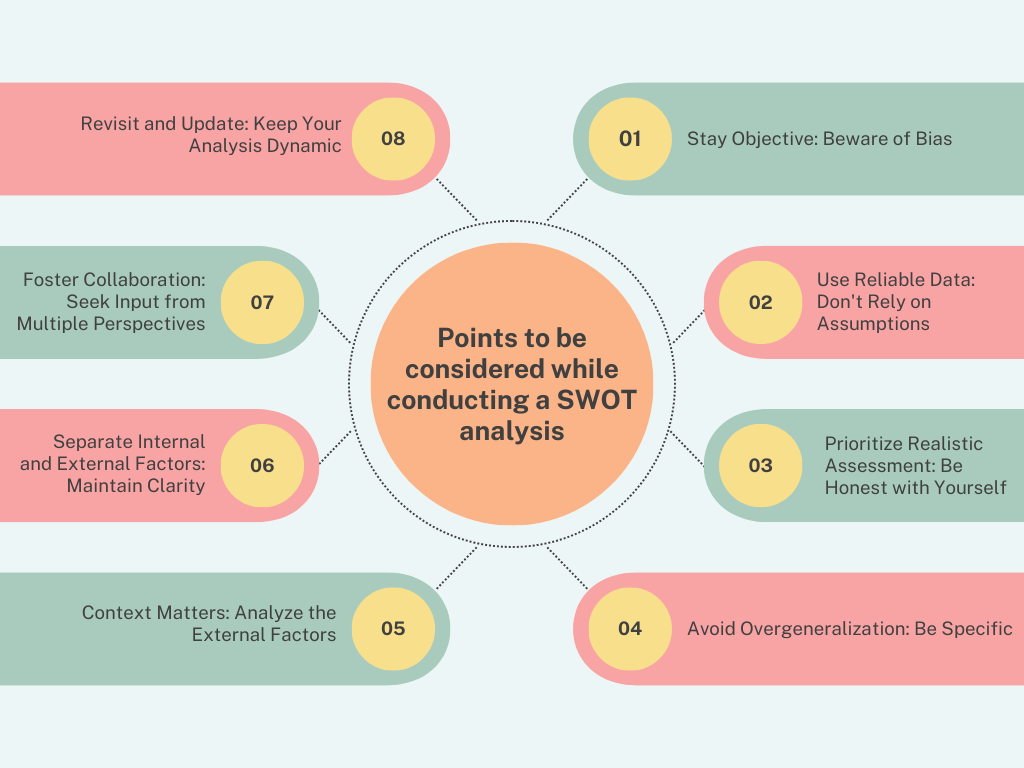Conducting a SWOT Analysis
Welcome, fellow managers and aspiring entrepreneurs, to the world of SWOT analysis! In this blog post, we will dive deep into the intricacies of conducting a SWOT analysis and how it can help you gain an edge in the business world. Get ready to unlock your superpowers and make informed decisions! So, grab your capes, put on your thinking caps, and let’s begin this adventurous journey!

1. Understanding SWOT Analysis:
To kick things off, let’s start by unraveling the acronym itself. SWOT stands for Strengths, Weaknesses, Opportunities, and Threats. This analysis framework provides a holistic perspective on your business or an idea, empowering you to evaluate internal and external factors that can influence success.
2. Assessing Strengths: Find Your Inner Superhero:
Strengths are the superpowers that set you apart from the competition. Consider what makes your business unique, such as valuable assets, expertise, or a strong brand presence. For example, let’s examine Uber. The company’s strength lies in its innovative technology and extensive network of drivers, allowing them to dominate the ride-hailing industry.
3. Confronting Weaknesses: Addressing Your Kryptonite:
Weaknesses are the areas that drain your superpowers. Be honest in recognizing areas of improvement, such as limited resources, inexperienced personnel, or outdated technology. Take Netflix, for instance. In the early 2000s, the company faced weak DVD distribution channels before transitioning to streaming as their primary focus.
4. Navigating Opportunities: Embrace the Superhero Universe:
Opportunities are the external forces that can empower your superpowers. Look for emerging trends, untapped markets, or gaps in the industry. Consider Tesla’s opportunity in the electric vehicle market, driven by increasing environmental concerns and government regulations.
5. Confronting Threats: Brace Yourself for Villains:
Threats are the challenges that can hinder your success. Identify competitors, changing consumer preferences, or economic downturns that may negatively impact your business. To illustrate, Airbnb faced regulatory challenges and hotel industry opposition as it disrupted the traditional accommodation sector.
6. Case Study: Apple Inc.
No discussion on SWOT analysis would be complete without analyzing Apple Inc. Let’s examine their journey through the lens of SWOT analysis:
– Strengths: Apple’s brand loyalty, technological innovation, and seamless user experience are key strengths that have propelled the company’s success.
– Weaknesses: Despite their success, Apple has faced criticism for high pricing, limited product range, and over-reliance on iPhone sales.
– Opportunities: Apple capitalized on the opportunity presented by the growth of wearable technology, leading to the success of products like the Apple Watch.
– Threats: Strong competition from Android-based devices, intellectual property challenges, and changing consumer preferences pose threats to Apple’s market dominance.
7. Bringing it All Together: Actionable Insights
The power of SWOT analysis lies in its ability to provide actionable insights. Once you have assessed your strengths, weaknesses, opportunities, and threats, it’s time to develop strategies that leverage your strengths, address weaknesses, seize opportunities, and mitigate threats. Remember, knowledge without action is like a superhero without a cape.
Points to be considered while conducting a SWOT analysis

1. Stay Objective: Beware of Bias:
One of the most critical precautions when conducting a SWOT analysis is to maintain objectivity. It’s all too easy to let personal opinions, emotions, or preconceived notions sway your evaluation. To mitigate bias, involve a diverse team of stakeholders who can provide different perspectives and challenge the status quo.
2. Use Reliable Data: Don’t Rely on Assumptions:
A SWOT analysis should be data-driven rather than relying on assumptions or guesswork. Collect and analyze accurate and up-to-date information from reliable sources. This data can include market research, customer feedback, financial records, and competitor analysis. Remember, assumptions can distort your analysis and lead to poor decision-making.
3. Prioritize Realistic Assessment: Be Honest with Yourself:
To derive useful insights from SWOT analysis, you must honestly evaluate your strengths, weaknesses, opportunities, and threats. Avoid the tendency to overemphasize strengths or downplay weaknesses. By acknowledging and addressing potential challenges, you can develop effective strategies. Accepting the truth about your limitations is a sign of strength, not weakness.
4. Avoid Overgeneralization: Be Specific:
Another precaution is to avoid making broad or generic statements when labeling strengths, weaknesses, opportunities, or threats. Instead, be specific and provide detailed examples or evidence to support your analysis. For instance, instead of stating “Strong brand presence” as a strength, elaborate on how your brand recognition and customer loyalty impact your competitive advantage.
5. Context Matters: Analyze the External Factors:
When conducting a SWOT analysis, consider the context and external factors influencing your business or industry. Market trends, industry regulations, economic conditions, and technological advancements can significantly impact your analysis. Without accounting for these external factors, your analysis may lack depth and relevance.
6. Separate Internal and External Factors: Maintain Clarity:
To avoid confusion and ensure coherence, keep the analysis of internal factors (strengths and weaknesses) separate from the analysis of external factors (opportunities and threats). This clear differentiation allows for a more focused and comprehensive evaluation of each aspect, leading to better insights and strategies.
7. Foster Collaboration: Seek Input from Multiple Perspectives:
SWOT analysis can benefit greatly from collaboration and multiple perspectives. Encourage open discussions, brainstorming sessions, and input from different team members or departments. This collaborative approach helps uncover blind spots, sparks creativity, and enhances the quality of the analysis.
8. Revisit and Update: Keep Your Analysis Dynamic:
A SWOT analysis is not a one-time activity. As your business and the external environment evolve, regularly revisit and update your analysis. This ensures that it remains relevant, accurate, and reflective of the current reality. By keeping your analysis dynamic, you can adapt to emerging challenges and seize new opportunities effectively.
Conclusion:
Congratulations on harnessing the superpower of SWOT analysis! By understanding your strengths, weaknesses, opportunities, and threats, you can make informed business decisions, seize opportunities, and navigate challenges like a true superhero. Remember, this analysis is not a one-time exercise. Regularly revisit and update your SWOT analysis to stay ahead of the game. Embrace your inner superhero, go forth, and conquer the business world!
References:
– Uber: https://www.uber.com/
– Netflix: https://www.netflix.com/
– Tesla: https://www.tesla.com/
– Airbnb: https://www.airbnb.com/
– Apple Inc.: https://www.apple.com/
Samrat is a Delhi-based MBA from the Indian Institute of Management. He is a Strategy, AI, and Marketing Enthusiast and passionately writes about core and emerging topics in Management studies. Reach out to his LinkedIn for a discussion or follow his Quora Page

